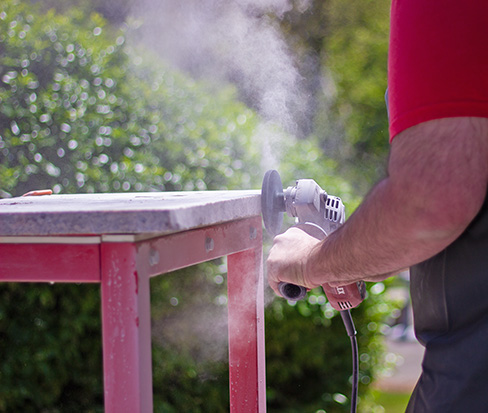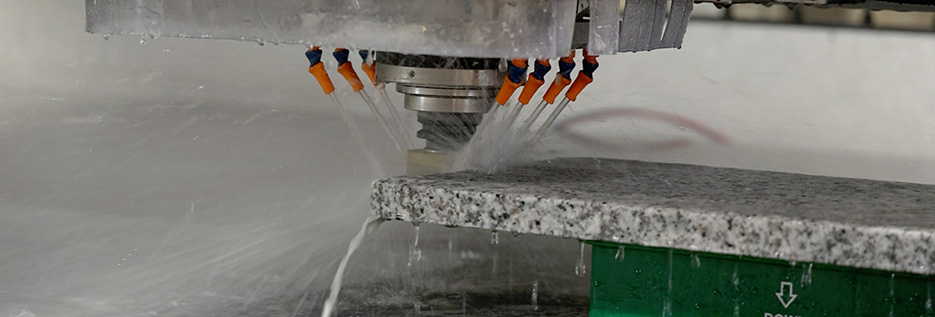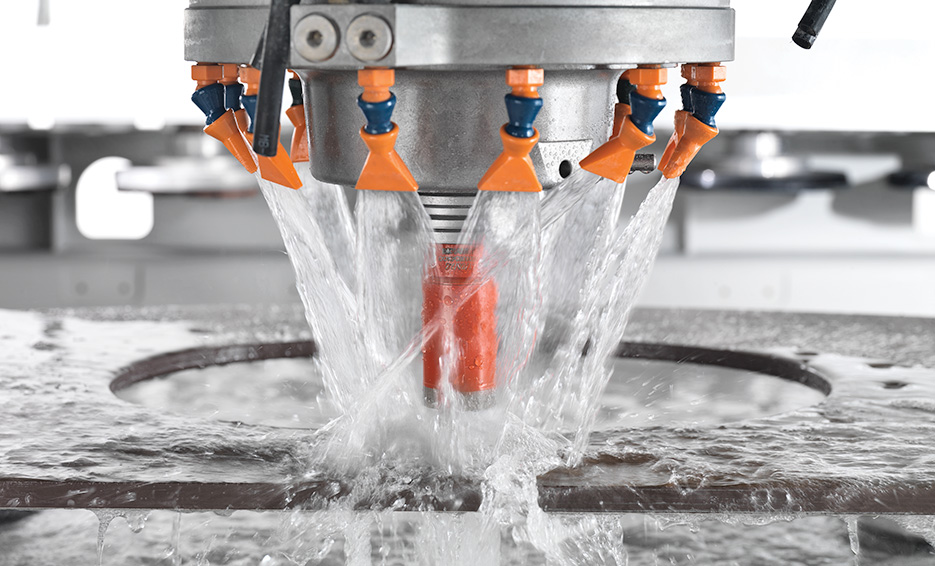Preventing Silicosis: The Renewed Focus On Silica Exposure in the Stone Industry
The Renewed Focus On Silica Exposure in the Stone Industry
 |
|
Proper masking and wet fabrication are part of managing dust from cutting, grinding and drilling stone. |
If you’ve been listening to the news these days, you may have heard some of the current controversy about the risks of silicosis dust generated while fabricating. New local regulations in California are specifically aimed at the manufacturers and fabricators of quartz products.
Clearly, this problem is not just going to go away. If not dealt with from every angle, first by industry professionals and leaders at the top, then through shops using these products, it promises to fester and grow bigger by the year. Though not a simple fix, it is simply one of those situations that if shops do not take responsibility, someone else will, and the result will not be pretty.
Ted Sherritt is one of those leaders. He’s the owner and CEO of FloForm, as well as a longtime member of the Artisan Group, The Rockheads, and is the newly appointed president of the International Surface Fabricators Association. Sherritt carries all the credentials needed to address this problem, and as you’ll see, he’s not afraid to speak up for our industry…
There are a significant number of issues in our industry today around silica safety, government regulation and legislation, and product bans. So many big picture problems, that I thought I could add some value to help our industry get through these things. These are risks, right? If engineered stone goes bad in North America, my business changes dramatically and so does everybody else’s and it would be a devastating day for our industry. So we need to work in unison with the Natural Stone Institute (NSI), the International Surface Fabricators Association (ISFA), the manufacturers, legislators and regulators to ensure that there is science around our belief that we are not harming our employees with silicosis.
If you’re doing it right and following the 2016 OSHA standards and operating below the action level for dust in your work areas, we believe that the work area is safe for the employee without a respirator. Our industry needs the science to prove that if we follow current regulations we are not harming our employees regardless of the product we are fabricating from quartzite, to engineered stone, to granite, to porcelain, and so on.
The good actors, they understand these rules, and work every day to make sure that their work environment is safe for their employees. There is air testing, medical monitoring and using wet practices, all the things we need to do to make a safe environment. The good actors are doing that, and doing their best to make sure their employees go home healthy after working in a safe environment.
 |
|
Wet fabrication has been the recommended best practice over a decade, and followed by the majority of the industry. |
On the flip side, there are two kinds of bad actors. There’s the bad actor who is uninformed and ignorant about the current laws, and the damage that silicosis can do. He’s happily working away and hoping that everything is going to be great. This bad actor needs education and awareness, and needs to understand that you have got to follow the rules or people are going to get sick. They need awareness from the ISFA, the NSI, and the manufacturers and their sales people to inform and educate them.
Then there are the worst kind of actors, the ones who know the rules, and know the damage that they are incurring by dry cutting and grinding. They also know it is cheaper and faster to do it this way, and there is more money to be made, but just don’t care and just keep on doing it with no regard to their employees’ safety. These are the ones who don’t and won’t follow regulations, and they need to be shut down! Enforcement needs to shut these guys down.
The good actors, the ones who are trying to do fabrication right, they should keep working to get the dust below the action level, to make their workplaces safe. These shops are the majority of the industry, and the bad shops are a small percentage. However, they are giving all of the good shops a bad name.
Unfortunately, the government has lumped us all together as fabricators, and has claimed that all fabricators are killing their workers. It’s not true and it’s not fair, but that’s what’s happening in the government’s regulatory areas – in California, anyway. Today, the law is that you have to wear a full respirator to work in a California stone shop. That’s the law, it’s not getting adequately enforced, but that is the law today.
In our FloForm shops, we do a bunch of air monitoring, and if we’re below the action level, we just keep on with production! As soon as we get above the action level, we’ll put in more air scrubbers, change engineering and administrative controls and do more house cleaning. It’s not easy to get below the action level everywhere, every time, but you have to keep working at it.
These are your employees. Quite often they are friends with your son, or your nephew or your own kid! You want those people to be safe, and not catch a disease that is not curable, but is preventable. So we need to do all we can do to operate a shop and prevent silicosis, because it is a terrible, incurable disease, and it only gets worse. The first day you find an employee with symptoms of silicosis and he or she tests positive, you’ve got to get them out of that environment, and get them a new job somewhere else, such as in sales or templating. It is your responsibility as a business owner or manager to ensure the safety and health of your employees.
A lot of these owners and workers are undocumented and not covered by workers compensation or alternative medical insurance. This is a major cause of the silicosis issue exploding in California today. Bad actors not following safety and employment regulations in place to safeguard employee health.
Additionally, so many people are buying engineered stone these days, that is why quartz is considered the problem. The success of this product category has dominated the countertop industry today, and if it was never invented and the same penetration happened with granite, the same problem would exist, and people would be still be suffering from silicosis today. But the fact that engineered stone came in and took a large market share from granite, is one more reason that this is an engineered stone issue, today.

What Can the Industry Do?
There are a bunch of answers to this problem. One answer is more inspections, and enforcement for the bad actors. We can identify them. It just needs the intestinal fortitude of OSHA to go deal with it. It’s enforcement for the bad actors who know they’re doing it wrong, but don’t care, and education for the ones who don’t know they are doing it wrong, so they can get better at it. It’s also engagement with associations like ISFA and NSI to help educate them on solutions and tools from our supply member partners, like air scrubbers and wet hand tools that use water to suppress the dust.
For the people who are doing it right, the answer is a pat on the back and recognition. We need to market to the fabricators who are doing it right, through the NSI, trade associations and the manufacturers, and they should get more customers, because in the end, doing fabrication right costs money. But if you really care about this industry and the people who work in the fabrication shops, you shouldn’t be buying from the cheapest guy out there, because they are most likely doing it the wrong way.
We know that OSHA can’t enforce the regulations effectively and quickly enough to close down all of these shops, so a bill was introduced into California’s legislature to require licensing of all fabricators. Fabrication shops have to prove they have wet shops, air monitoring, and they’ve trained their employees before they get a license to buy slabs from a distributor. This will take about three years before it is put into place and helping, but it’s not going to prevent more silicosis cases from happening while dry cutting and grinding is going on today.
Moreover, the class action lawyers are out there handing out pamphlets all across the nation to employees, saying, “Join us on a lawsuit, because we are going to sue the manufacturers who sell quartz countertops, because they didn’t tell us it was a danger.”
So the industry needs to regulate the suppliers, so the bad actors can’t get licenses, and sooner or later they won’t be able to buy materials, and they’ll have to get out of the business.
So education and awareness, controlling the supply channel, and increased OSHA enforcement is what I think the answers are, and if we don’t take action as an industry and improve the situation for the workers, we won’t be able to sell products containing silica – including granite and engineered stone – in North America. They’ve already done this with engineered stone in New Zealand and Australia.
The stories on today’s news headlines need to be about good stone companies, the ones doing it right that have no sick people. Again, silicosis is an incurable lung disease that results in debilitating injuries to workers and significantly impacts their lives and their families. The good news is that silicosis is preventable if we all do the right thing.
See this article for more resources on safe fabrication practices from NSI.